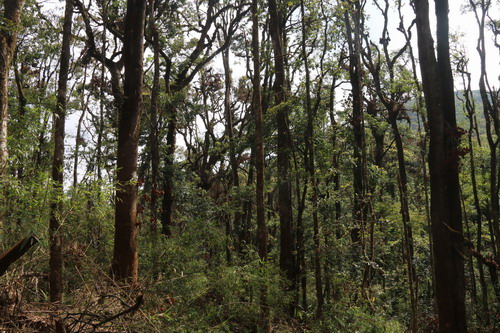中科院版纳植物园郑征研究组揭示树洞在活空心树内发展缓慢但

functional Ecology发表中国科学院西双版纳热带植物园土壤生态组副研究员郑征及张树斌等科研人员一篇题为“Hollows in living trees develop slowly but considerably influence the estimate of forest biomass ”的研究结果。文章揭示树洞在活空心树内发展缓慢但显著影响森林生物量估计。
空心树广泛生长于全球森林尤其是老林中,由于它们能够为动物提供筑巢和繁殖后代的场所而被认为是森林的重要结构。空心树是由微生物进入树干或大枝的破损处,分解内部心材后形成的。分解作用能导致树干内形成树洞甚至空管,从而造成碳储量损失并影响森林碳收支。树洞内木质分解速率控制了树洞的扩张速率与供给,还可影响树干的碳损失。然而,直到目前为止人们还不清楚树洞木质的分解速率究竟是多少。
中国科学院西双版纳热带植物园土壤生态组副研究员郑征及张树斌等科研人员,在我国西南哀牢山亚热带山地森林中,首次测定了活树树洞分解木的呼吸速率、水分含量及木质密度,并由此计算出树洞的扩展速率和巢位洞形成的时间。同时通过确定树干中树洞体积占比与树木胸径的回归关系,利用森林调查数据估计了树洞造成的生物量损失。另外,还比较了树洞分解木与倒木和枯立木在呼吸速率和含水量方面的差异。研究发现树洞内木质分解速率比倒木约低50%,原因与其相对较低的含水量有关,因此可以利用倒木的分解速率来估计树洞的分解速率。树洞在水平方向的辐射扩展速率平均为2 mm/年,略低于森林中树干茎粗生长速率,但树洞在垂直方向的扩展速率是水平方向的8倍。在这一分解速率下,大约需要50-100年时间才能够形成大小尺度足够供中华蜜蜂(Apis cerana cerana)筑巢的树洞。由于栖息于这一森林中的啄木鸟只能开凿小尺度的树洞,对于需要大尺度洞巢的动物而言,只能依靠缓慢的分解作用来提供洞巢。研究还揭示树洞分解可造成树干8%的生物量损失,影响利用生物量模型对森林生物量的估计。因此在进行老林生物量估计时,需要考虑树洞的影响。
原文链接:
Hollows in living trees develop slowly but considerABLy influence the estimate of forest biomass
原文摘要:
Summary
The decomposition of wood inside living tree hollows influences forest structure and processes. Although the decomposition rate controls the formation of hollows, it has not previously been measured.
In an old-growth subtropical montane evergreen broad-leaved forest in south-west China, we measured respiration rates of decaying wood inside living tree hollows, logs (downed tree trunks) and snags (standing dead trees) using infrared CO2 analysis. We compared stem radial growth rates to the horizontal expansion rates of hollows. We also estimated the proportion of hollows to total stem volume and the time required to form nesting hollows.
Overall, decaying wood inside living tree hollows had significantly higher wood density but lower a moisture content and respiration rate than logs. Wood moisture content and wood density significantly affected the respiration rates of wood inside tree hollows and logs and snags. The average respiration rate of wood inside tree hollows (0·16 ± 0·02 μmol kg−1 s−1) was 49% lower than in logs and 34% lower than in snags.
The proportion of stem volume occupied by hollows was 8·0% in this forest. The rADIal expansion rate of tree hollows was 2·0 mm year−1, which was slightly less than the stem radial growth rate. The rate of vertical expansion of hollows was eight times higher than radial expansion. At these rates, it would require 50–100 years for the formation of hollows large enough for honeybees Apis cerana cerana to nest.
We conclude that wood decomposition inside tree hollows is more strongly limited by moisture content than in logs, and a very long time is required to form nesting hollows by decomposition. However, the decomposition of wood inside living tree hollows can considerably influence estimates of stem biomass in old-growth forests.
doi: 10.1111/1365-2435.12566
作者:郑征

